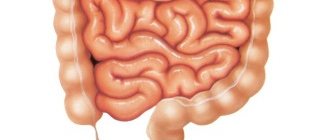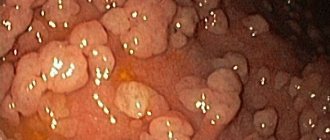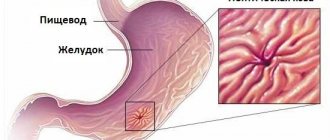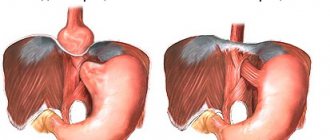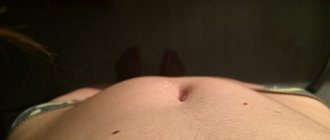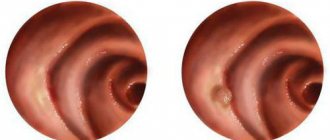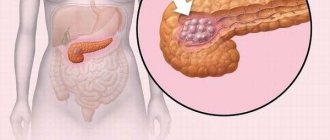Characteristics of the disease
The main function of the stomach is to accept food from the esophagus, digest it and push the resulting mass further into the intestines. Therefore, disruption of its work is expressed in a slowdown in the passage of food during contraction of smooth muscles. Typically, the stomach muscles make wave-like movements directed from top to bottom.
And with gastric dyskinesia (lat. dyskinesia; gaster), the food entering it moves in the opposite direction. As a result of improper functioning of the organ, the patient experiences unpleasant sensations: nausea, belching and vomiting.
At this time, the bile produced by the liver, after passing through the gallbladder, during contraction with the correct reflexes of the ducts, enters the stomach through a special passage - the sphincter. Here it is mixed with the contents (food, etc.) so that after digestion it enters the intestines. A violation of this sequence occurs when the sphincter contracts incorrectly. This is possible with diseases of the bile ducts, liver or dyskinesia: bile accumulates in the stomach and, when released back, enters the esophagus and oral cavity. The result is a feeling of bitterness in the mouth (heartburn).
Most often, the diagnosis of Dyskinesia is made in children and young people, as well as in patients with functional and organic diseases of the central nervous system.
Prognosis and prevention
The prognosis for gastric dyskinesia is favorable. The pathology is treatable, however, all patients are required to be registered with a dispensary. In the absence of treatment or with inadequate therapy, destructive changes in the mucosa may develop, which significantly worsens the condition and prognosis.
Prevention of the development of dyskinesia consists of properly organized nutrition and timely treatment of gastritis and other gastrointestinal diseases. In addition, it is necessary to give up bad habits, proper organization of work and rest, and a positive attitude.
So, gastric dyskinesia is a functional disorder without organic changes in the organ. The disease can occur in a hyper- or hypokinetic type. Both varieties respond well to treatment. But in the absence of treatment or if it is carried out incorrectly, the risk of developing organic lesions of the stomach increases.
Causes of the disease
The development of the disease can be triggered by external and internal factors and diseases:
- genetic predisposition;
- diseases of the central nervous system;
- pathologies in the gastrointestinal tract (cholecystitis, viral hepatitis, enteritis);
- pathologies of the cardiovascular system;
- food allergies (to eggs, milk or fish);
- rheumatic diseases;
- diseases of the kidneys, lungs or endocrine glands (improper production of hormones and enzymes);
- unhealthy diet (systematic consumption of dry food, quick snacks, consumption of large amounts of spicy, smoked and fatty foods, carbohydrates);
- chronic alcoholism and tobacco smoking;
- stressful situations;
- improper sedentary lifestyle;
- deficiency of vitamins, proteins and microelements in the body;
- the climate in the country of residence is too hot;
- as a result of prolonged exposure to radiation;
- taking medications.
However, most often the development of the disease is sharply influenced by pathologies of nearby organs:
- stomach and duodenal ulcers;
- diseases of the biliary tract;
- the presence of parasites (worms) in the stomach and intestines;
- pancreatitis;
- peritonitis (purulent inflammatory process);
- thrombosis of gastric vessels;
- pneumonia;
- myocardial infarction;
- severe infections (typhoid fever, etc.);
- stomach or spinal cord injuries.
Causes
The stomach is a hollow organ that has several layers, including muscle. The muscle fibers of the stomach normally contract at a pace and rhythm that is sufficient to push a portion of chyme (partially digested food) of a certain volume and consistency into the duodenum for subsequent digestion. Regulatory mechanisms (in particular, nervous and endocrine) are established in such a way that when the muscle fibers of the stomach contract, it is taken into account what consistency (more or less dense) chyme and in what volume should be pushed through the digestive tract. If there is little chyme (for example, if a person had a snack on the run or ate a traditional light breakfast), then for its further transportation less effort is made on the part of muscle fibers than for pushing a large lump of partially digested food (for example, absorbed during a large lunch or protracted banquets) ).
Gastric dyskinesia occurs when a malfunction occurs in the regulatory mechanisms responsible for gastric motility (its motor activity).
All the reasons that can cause dyskinesia are:
- exogenous - this is the effect of external unfavorable factors;
- endogenous – pathologies of the body that provoke disruption of gastric motility.
First of all, gastric dyskinesia can be triggered by changes:
- location of the stomach;
- its volume.
Most often, the disease occurs with such changes in the stomach as:
- extension;
- omission.
In turn, gastric dyskinesia can be provoked by such types of prolapse as:
- primary - the child is already born with such a developmental anomaly in the gastrointestinal tract;
- secondary - it occurs in a healthy person against the background of pathologies or conditions (for example, after an unsuccessful operation for a stomach disease or during pregnancy, when internal organs change their location due to a pregnant uterus).
Secondary gastric prolapse, which can lead to dyskinetic disorders on its part, may have no apparent cause - in this case it is called idiopathic.
Dyskinesia caused by congenital pathologies of the stomach is called primary, and that arising due to acquired diseases of this organ is called secondary.
Secondary gastric dyskinesia is much more common than primary dyskinesia. It is observed in such forms as:
acute atony (or paresis of muscle fibers) - in this case, the gastric wall contracts to the maximum (due to maximum contraction of muscle fibers) or, on the contrary, stretches and becomes functionally insufficient;- pneumatosis - some pathogenic microorganisms (in particular, causative agents of anaerobic infection - primarily clostridia) are capable of producing a huge amount of gas during their life activity, which, accumulating in the stomach cavity, stretches it, due to which the muscle fibers weaken and lose the ability to normal contraction necessary to move chyme through the gastrointestinal tract.
In turn, gastric atony most often occurs against the background of such diseases and conditions as:
- peritonitis (acute inflammation of the peritoneum);
- pneumonia (due to the proximity of the lungs and stomach, the process in the former can affect the functional state of nearby organs);
- intraoperative trauma to the stomach - due to technical errors of surgeons due to imperfect skills or technical difficulties (for example, with an atypical location of the stomach, abundantly overgrown connective tissue cords (with severe adhesive disease), neoplasm in the wall of the stomach, and so on);
- abdominal injuries in which the stomach is affected - both open (gunshot, cutting, stabbing, chopped) and blunt, without damaging the integrity of the anterior abdominal wall.
The most common causes that directly lead to gastric dyskinesia are nutritional (food) factors. The most typical are:
- eating dry food - it is more problematic for it to move in the stomach cavity towards the duodenum;
- low-quality food, which is poorly digested and complicates the work of the stomach to move it. First of all, this is stringy meat, coarsely chopped salads or salads, for the production of which they used hard, limp, too hard (for example, not fully ripened) vegetables or fruits;
incorrect, chaotic diet, especially if a person does not eat all day, and then eats up, trying to compensate for missed meals;- hasty absorption of food - in this case, a person does not have time to chew it normally and often swallows whole pieces, as well as large lumps of food;
- excessive predominance in the diet of foods rich in carbohydrates (namely bread, pastries, cakes, puff pastries, pies and donuts) and fats;
- abuse of dishes with an abundance of seasonings - they irritate the gastric mucosa, and the muscle layer reacts to this reflexively.
After nutritional factors, gastric dyskinesia is most often caused by:
- exposure to organic and synthetic toxins – primarily chemicals, alcohol, tobacco, and some medications;
- temperature effects - in particular, stomach burns (for example, excessively hot food).
The internal prerequisites associated with the occurrence of gastric dyskinesia include the following factors:
- food allergies (most often intolerance to dairy products, fish, eggs, citrus fruits and chocolate);
- a number of diseases of the gastrointestinal tract - most often acute and chronic cholecystitis (equally calculous (stone) and non-stone), viral damage to liver tissue (primarily viral hepatitis), enteritis of various origins, and so on;
- diseases of the cardiovascular system - primarily myocardial infarction and hypertensive heart disease, as well as incipient hypertensive changes in the vascular system, which cannot yet be called full-fledged hypertension;
- autoimmune disorders on the part of the body - most often it is rheumatism, but systemic lupus erythematosus and autoimmune Hashimoto's thyroiditis can also give rise to disruption of the neurohumoral regulation of the stomach;
- disorders of the central nervous system, which can be observed as a result of chronic (or severe acute) stress, cerebrovascular accident (stroke) and damage by pathogenic microorganisms (encephalitis);
- kidney disease;
- pathology of the endocrine system;
- lung diseases.
Important
It may seem that some of the internal factors cannot in any way be associated with gastric dyskinesia - but the connection is understandable: in these diseases, the nervous and endocrine regulatory mechanisms are disrupted, and this, in turn, leads to impaired gastric motility.
Forms of the disease
The forms of the disease are divided depending on the type of gastric motility disorder:
- Hypomotor dyskinesia of the stomach - manifests itself in a decrease in the activity of this organ. As a result, food accumulates and undigested waste stagnates, and the process of fermentation and gas accumulation (pneumatosis) develops. Manifests itself in foul-smelling belching and a feeling of squeezing.
- Hypermotor dyskinesia of the stomach - characterized by strong motor activity and a condition when the contents of the stomach and duodenum are refluxed into the esophagus, which is manifested by heartburn, sour belching and a gag reflex due to spasms.
- Atonic form - manifests itself in a violation of the evacuation (removal) of food masses from the organ, expressed by pain (heaviness, etc.), weakening of muscles, as a result of which chronic constipation and accumulation of waste in the body develop.
All three forms of the disease can lead not only to disturbances in the digestive process, but also cause the body to not receive the necessary nutrients, the development of vitamin deficiency and deterioration of health.
Gastric dyskinesia: what it is, causes, symptoms, diagnosis and treatment of the disease
Good afternoon, many will be interested in understanding their health and their loved ones, and I will tell you my experience, and we will talk about the symptoms and treatment of gastric dyskinesia. Most likely, some details may differ, as was the case with you.
Please note that you should always consult with highly specialized specialists and not self-medicate. Naturally, you can quickly find the answer to the simplest questions and diagnose yourself.
Write your questions/suggestions in the comments, and together we will improve and supplement the quality of the material provided.
Types of gastric dyskinesia
Gastric dyskinesia in children and adults can be triggered by changes in the position and volume of the organ (expansion, prolapse) against the background of motor dysfunction (acute atony, pneumatosis). In this regard, they distinguish:
- primary prolapse, when a congenital anomaly is observed;
- secondary prolapse, when changes in the position of an organ - acquired, for example, occur after pregnancy.
Secondary violation occurs in the form of:
- acute atony or muscle paresis, when the walls of the stomach reflexively compress or stretch against the background of other pathologies and disorders, for example, with a heart attack, inflammation of the peritoneum or lungs, postoperative, blunt or gunshot injuries;
- pneumatosis, when an excessive amount of gases is formed in the stomach due to the activity of certain microorganisms, against the background of which its expansion occurs and contractile function weakens.
Depending on the type of motor dysfunction, they differ:
- hypertensive dyskinesia, when motor function is overly active;
- hypotonic pathology, when peristalsis decreases;
- atonic, when motor function is completely absent.
Based on their characteristic features, the disease is classified into the following types:
- painful;
- dyspeptic;
- mixed.
According to the causative factors, gastric upset can be:
- exogenous, caused by external adverse influences;
- endogenous, arising against the background of internal pathologies in the body.
According to the variants of course and development, gastric dyskinesia has the following forms:
How often does it occur?
In the field of gastroenterology, motor indigestion is common - in 1/3 of patients with complaints of disorders in the gastrointestinal tract, who do not have other morphological changes. The disorder is common in young people, especially children, and in the group of patients with central nervous system diseases of a functional or organic nature.
Description
Gastric dyskinesia in adults and children is functional in nature and manifests itself in the form of motor disturbances in the functioning of the digestive tract. As a rule, it is accompanied by various gastric disorders and non-localized pain syndrome.
When performing gastroscopy with biopsy, inorganic transformation of cells is not detected.
Quite often, this diagnosis is made with more serious disorders of the gastrointestinal tract, genitourinary or nervous system, so dyskinesia is determined only after excluding all possible organic pathologies using modern diagnostic methods.
Internal provocateurs for the development of pathology include:
Spastic (hypermotor) intestinal dysfunction
This type of disease is manifested by severe, cramping pain in the abdominal area. Attacks occur that worsen and subside. The patient experiences abdominal tension, irritation, bursting pain and constant belching. Increased flatulence, bloating and sour belching are also observed. Then diarrhea occurs.
Atonic (hypomotor)
This type of dyskinesia occurs against the background of weakened intestinal motility and colon motility. With weakened motor activity, stagnation occurs, manifested by constipation.
This condition is more dangerous, since chronic constipation leads to intoxication of the body due to stagnation of feces. Associated symptoms of dyskinesia are belching, weakness, abdominal distension, and pain in the intestines. Constant constipation is fraught with the appearance of hemorrhoids.
Feces with excessive hardness injure the sphincter arch, which leads to complications.
Symptoms of dyskinesia
The disease is characterized by a number of unpleasant manifestations that differ for each sick person. The initial and common symptom is pain in the epigastric region. The nature of the pain is also different.
There may be aching, uncomfortable sensations with dull and boring manifestations that last from several minutes to several hours.
The patient cannot characterize the location of the pain; there is a feeling that the entire gastrointestinal tract hurts.
Unpleasant sensations subside during sleep. After waking up, the discomfort may return again.
Some patients experience an exacerbation of discomfort after eating, due to nervousness or under various types of stress.
Associated signs of intestinal dyskinesia are flatulence, distension and bloating, belching, and pain. There may be a urge to defecate. If gas formation stops or defecation occurs, the discomfort goes away.
In many cases, intestinal dyskinesia can only be suspected when there is discomfort and bloating. Not all patients develop stool disorder, which makes diagnosis difficult.
Another option for the occurrence of the disorder is the alternation of constipation with diarrhea and mucus in the stool.
Some studies have found a connection between intestinal dyskinesia and mental disorders.
Patients suffering from the disease had behavior prone to nervousness. There was an increased level of stress, anxiety, and a tendency toward depressive disorders. Such individuals may experience pain in the heart or back, but after examination it turns out that these organs are healthy. Conclusion - the disease is partly psychogenic in origin.
Less common is a mixed type of large intestinal dyskinesia, which includes an alternation of symptoms characteristic of both hypertensive and hypotonic types.
Classification of types of dyskinesias
The development of dyskinesia in adults and children is often provoked by changes in the volume of the stomach (prolapse, expansion), its position when organ dysfunction occurs.
There are two types of omissions:
- primary – with a congenital anomaly;
- secondary, when the position of the stomach changes due to some factors (pregnancy, etc.).
The latter can occur for several reasons:
- in case of acute atony or paresis of muscles - the walls of the stomach are compressed/decompressed by pathology reflexively (with inflammation, heart attack, after surgery or as a result of injury);
- pneumatosis is the accumulation of a large volume of gases in an organ due to the negative activity of bacteria, which causes a change in its contractile function.
There are several types of gastric dyskinesia, which differ in the course and development of the disease:
- cardiospasm, in which there is a sharp contraction of the cardiac department, which causes a violation of the swallowing function and severe pain in the chest area;
- pylorospasm is characterized by the appearance of spasms in the pyloric region of the stomach, resulting in a violation of the evacuation of contents, which is accompanied by feelings of discomfort, belching and an acidic taste in the mouth;
- tetany – the development of spasms in the form of convulsions, which provokes severe pain and gastrocardial syndrome;
- acute dilatation of the stomach - occurs when the tone of the walls decreases due to constant overeating, excessive gas formation, or as a result of surgical intervention;
- aerophagia - disturbances in the functioning of the stomach occur due to the high rate of consumption of food along with air bubbles.
Causes of functional disorder
Most often, gastrointestinal pathology is caused by nutritional disorders.
Gastric dyskinesia develops due to the influence of such factors:
- eating disorder;
- the predominance of dry, fatty and spicy foods, large amounts of carbohydrates;
- swallowing food in large chunks;
- exposure to chemicals, alcoholic beverages, tobacco and medications;
- burns;
- exposure to high temperatures;
- food allergies;
- diseases of the gastrointestinal tract;
- disruption of blood vessels and heart function;
- autoimmune diseases;
- diseases of the nervous system;
- endocrine pathologies.
Return to contents
Symptoms of gastric dyskinesia
Manifestations of the disease are varied, the main ones being:
- pain and cramps in the abdominal area (in the epigastric region, hypochondrium, near the navel);
- the duration of the attack can be from 2-3 minutes to several weeks;
- different pains (cramping, pressing, aching);
- manifestations of flatulence;
- regular constipation or diarrhea;
- feeling of heaviness in the stomach;
- hiccups, sour belching, heartburn, nausea;
- vomiting profuse greenish mass, repeated periodically.
In many patients, attacks of pain or vomiting can be observed against the background of stress or psychological trauma, or strong emotional experiences. Symptoms usually improve at night.
Symptoms
The main symptom of gastric dyskinesia is pain in the abdominal area, which does not have a specific localization. Discomfort can be felt in the epigastrium, in the navel area, under the ribs. In this case, attacks have different durations - several minutes, hours or even weeks.
The pain syndrome also has a different character. Some people complain of cramping sensations, others suffer from aching or pressing discomfort. These features depend on the nature of the motor impairment and the severity of the disease.
Symptoms of the pathology are usually not related to food. In most cases, their appearance is influenced by neuropsychic factors.
When antiperistaltic contractions occur and acidic stomach contents enter the esophagus, a person develops heartburn. Patients also often complain of sour belching. With a strong decrease in organ contractions, its contents stagnate. In this case, belching appears with a rotten smell.
If dyskinesia, which has developed against the background of damage to the central nervous system, is accompanied by damage to the vomiting center, the person experiences profuse vomiting that does not bring relief.
All symptoms of impaired organ motility can have varying degrees of intensity. However, they cannot be called specific, because similar manifestations accompany many other pathologies.
Nevertheless, dyskinesia is characterized by the presence of a connection between the appearance of symptoms of the disease and psychological trauma or stressful situations. The complaints of such patients are variable and may decrease at night.
Many experts note the following variants of gastric dyskinesia:
- cardiospasm - accompanied by contraction of the cardia and causes difficulty swallowing and severe chest pain;
- pylorospasm - in this case, the pyloric region contracts, which provokes problems with the evacuation of gastric contents, sour belching, and epigastric discomfort;
- tetany - in this case, convulsive spasms appear, which cause severe pain and the development of gastrocardial syndrome;
- acute dilatation of the organ - appears with constant overeating or after surgery in case of decreased stomach tone;
- aerophagia - in this situation, functional disorders are observed, which are a consequence of rapid swallowing of food with a large volume of air.
Diagnosis of the disease
To determine the exact form of gastric dyskinesia, you should consult a gastroenterologist and undergo a full examination:
- examination and palpation of the abdomen - allows you to determine the soreness or expansion of the organ;
- take blood (biochemical), urine and stool tests;
- electrogastrography (for motility disorders) – allows you to determine the electrical potentials during contraction of the stomach muscles (strong variability appears);
- fluoroscopy – helps to identify spasm, pylorospasm, cardiospasm, prolapse;
- ultrasound examination (ultrasound);
- gastroscopy – visual examination of the digestive tract using a probe with a camera;
- esophagogastroduodenoscopy (at the same time, a biopsy is taken to examine tissues and determine organic disorders).
The examination allows you to determine the form of the disease, its degree and clarify subsequent treatment.
Diagnostics
To identify gastric dyskinesia, you should contact a gastroenterologist who can determine the causes of the development of this disease. During palpation, the specialist will detect pain. If a person has atony, the doctor can detect enlargement of the organ.
To detect motility disorders, electrogastrography is indicated. Fluoroscopy of the stomach also has high diagnostic value. With its help, you can identify spasm or hypotension of the organ, problems with peristalsis, prolapse of the stomach, etc. Another mandatory study is gastroscopy, which helps to detect thickening of the folds of the organ mucosa.
Diet
For any form of the disease, be it dyskinesia of the stomach, intestines, biliary tract or other organs, you must follow the following diet:
- food intake is carried out fractionally (in small portions), overeating should be avoided;
- you need to eat 5-6 times during the day;
- Spicy, smoked, fatty foods, foods with spices, etc. are not recommended;
- alcoholic beverages are prohibited;
- You should limit your consumption of foods high in fiber (vegetables, berries and fruits, bread, cereals and pasta, legumes and nuts).
To restore normal function and balance, it is recommended to follow a more restrictive diet for two weeks, consuming food only in chopped or pureed form (minced meat); dilute fruit juices with water, and exclude vegetable juices from the menu; add chopped greens.
Treatment
This pathology is usually treated on an outpatient basis.
If a person has intense pain, he may be hospitalized for detailed diagnostics. For treatment to be effective, the diet must be adjusted. To restore nervous regulation of motor skills, the doctor prescribes neurotropic and psychotropic drugs. There is also often a need to use sedatives.
To restore the contractile function of the organ in hyperkinetic syndrome, M-anticholinergics are prescribed. If a person has hypokinesia, caffeine and aminophylline are indicated. When atony is detected, it becomes necessary to take proserin.
In most cases, dyskinesia is accompanied by a violation of the secretory function of the stomach. Therefore, replacement treatment is required, which includes the use of gastric juice, enzyme preparations, and acidin-pepsin.
Physiotherapy helps achieve good results in the development of dyskinesia. The doctor may prescribe electrophoresis with novocaine, diathermy, paraffin treatment, therapeutic mud and warming procedures. The choice of a specific method is influenced by the form of motor impairment and the predominant clinical syndrome.
How to treat gastric dyskinesia
Complex therapy includes the main areas:
- diet;
- taking medications;
- physiotherapy, massage, physical therapy;
- herbal medicine;
- in extreme situations - surgery.
The list of medications includes the following groups of drugs:
- sedatives - neurotropic and psychotropic drugs are prescribed to restore the nervous system and normalize motor skills;
- M-anticholinergics – allow for correction of the contractile function of the stomach in hypersyndrome;
- for hypomotor gastric dyskinesia - means of stimulating contraction of the muscle walls (Eufillin, Caffeine);
- in the atonic form - drugs to trigger peristalsis (“Proserin”);
- Special enzymes (“Acidin-pepsin”) are prescribed as replacement therapy.
What treatment is needed?
Gastric hypertension is a common disease that affects a person’s quality of life. When the first symptoms appear, it is necessary to undergo a timely diagnosis and apply all necessary therapeutic measures. With such a disease, you cannot self-medicate. The doctor will examine the patient, refer him to all the necessary diagnostic methods, determine the diagnosis and draw up a treatment plan. To cure gastric hypertonicity, a specialist will prescribe medications, dietary nutrition and physiotherapeutic procedures.
Drug therapy
For gastric dyskinesia, the medications presented in the table are prescribed:
| Pharmacological groups | Drugs |
| M-anticholinergics | "Gastrozem" |
| "Riabal" | |
| Antispasmodics | "Papaverine" |
| "Drotaverine" | |
| Enzyme preparations | "Festal" |
| "Mezim" | |
| Anticholinesterase drugs | "Prozerin" |
| "Neostigmine" |
Return to contents
Diet for illness
If you have gastric dyskinesia, you must adhere to a diet. It assumes:
- Fractional meals in small portions 5-6 times a day.
- Exclusion of sweet, fatty, salty and spicy foods.
- Drinking enough liquid. At least 2 liters per day is recommended.
- Inclusion of fermented milk products, vegetables and fruits in the diet.
- Preparation of various soups and cereals.
- Eating lean fish and meat.
- Cooking baked, boiled, steamed.
Physiotherapy for the treatment of dyskinesia
Physiotherapeutic methods have a positive effect in the treatment of gastric dyskinesia, helping to relieve spasms and pain.
Main events:
- electrophoresis in the stomach area with novocaine helps relieve pain;
- mud applications;
- warming procedures (ozokerite, paraffin therapy, etc.);
- diathermy - hardware warming and stimulation of blood circulation using high-frequency alternating current, which promotes tissue restoration;
- baths based on mineral water;
- UHF and microwave.
During the therapy period, doctors advise patients to avoid all negative factors that can cause a worsening of the condition. These include, first of all, violations in the dietary menu and nervous tension. It is necessary to lead a healthy lifestyle, eat right and avoid any stressful situations.
Forecast
The prognosis is positive in the vast majority of cases. Deterioration is predicted only in the case of a long-term, advanced pathology, when the patient suffers from dyskinesia for years and does not take any steps to cure the pathology.
After treatment, relapses are not observed if the diet is followed and the patient avoids stressful situations.
Kovtonyuk Oksana Vladimirovna, medical observer, surgeon, consultant doctor
11 total today
( 52 votes, average: 4.85 out of 5)
Stomach polyp: symptoms and treatment
Stomach bezoar: causes, symptoms and treatment
Related Posts
Dyskinesia in children
The disease is considered rare in childhood. However, sometimes gastric dyskinesia occurs in children in the first months of life (more often in boys). At the initial stage, the disease usually does not manifest itself in any way.
Symptoms of the disease that are present in children:
- pain in the abdomen, belching with the smell of rotten eggs;
- the child completely refuses to eat;
- constipation may occur;
- sudden vomiting (greenish mass);
- breathing disorder (occurs due to an increase in the concentration of gases and pressure on the diaphragm) - breathing difficulties and pain in the chest area may occur;
- sensation of squeezing in the stomach area.
Examination and diagnosis in children are carried out using the same methods as in adults. Treatment of the disease is carried out in a similar way, however, implementation of dietary recommendations falls entirely on the shoulders of the parents. The child can eat only in small portions and often, adhering to the above restrictions and the advice of doctors.
Gastric dyskinesia: causes, symptoms and diagnosis, treatment methods, reviews
Dyskinesia is a disorder of motor acts of smooth muscles of various internal organs of a person. Gastric dyskinesia is one of the common pathologies in gastroenterology, which is expressed in a functional impairment of the motor function of the stomach.
Characteristics of the disease
The main function of the stomach is to accept food from the esophagus, digest it and push the resulting mass further into the intestines. Therefore, disruption of its work is expressed in a slowdown in the passage of food during contraction of smooth muscles. Typically, the stomach muscles make wave-like movements directed from top to bottom.
And with gastric dyskinesia (lat. dyskinesia; gaster), the food entering it moves in the opposite direction. As a result of improper functioning of the organ, the patient experiences unpleasant sensations: nausea, belching and vomiting.
At this time, the bile produced by the liver, after passing through the gallbladder, during contraction with the correct reflexes of the ducts, enters the stomach through a special passage - the sphincter. Here it is mixed with the contents (food, etc.) so that after digestion it enters the intestines.
A violation of this sequence occurs when the sphincter contracts incorrectly. This is possible with diseases of the bile ducts, liver or dyskinesia: bile accumulates in the stomach and, when released back, enters the esophagus and oral cavity.
The result is a feeling of bitterness in the mouth (heartburn).
Most often, the diagnosis of Dyskinesia is made in children and young people, as well as in patients with functional and organic diseases of the central nervous system.
Causes of the disease
The development of the disease can be triggered by external and internal factors and diseases:
- genetic predisposition;
- diseases of the central nervous system;
- pathologies in the gastrointestinal tract (cholecystitis, viral hepatitis, enteritis);
- pathologies of the cardiovascular system;
- food allergies (to eggs, milk or fish);
- rheumatic diseases;
- diseases of the kidneys, lungs or endocrine glands (improper production of hormones and enzymes);
- unhealthy diet (systematic consumption of dry food, quick snacks, consumption of large amounts of spicy, smoked and fatty foods, carbohydrates);
- chronic alcoholism and tobacco smoking;
- stressful situations;
- improper sedentary lifestyle;
- deficiency of vitamins, proteins and microelements in the body;
- the climate in the country of residence is too hot;
- as a result of prolonged exposure to radiation;
- taking medications.
However, most often the development of the disease is sharply influenced by pathologies of nearby organs:
- stomach and duodenal ulcers;
- diseases of the biliary tract;
- the presence of parasites (worms) in the stomach and intestines;
- pancreatitis;
- peritonitis (purulent inflammatory process);
- thrombosis of gastric vessels;
- pneumonia;
- myocardial infarction;
- severe infections (typhoid fever, etc.);
- stomach or spinal cord injuries.
Forms of the disease
The forms of the disease are divided depending on the type of gastric motility disorder:
- Hypomotor dyskinesia of the stomach - manifests itself in a decrease in the activity of this organ. As a result, food accumulates and undigested waste stagnates, and the process of fermentation and gas accumulation (pneumatosis) develops. Manifests itself in foul-smelling belching and a feeling of squeezing.
- Hypermotor dyskinesia of the stomach - characterized by strong motor activity and a condition when the contents of the stomach and duodenum are refluxed into the esophagus, which is manifested by heartburn, sour belching and a gag reflex due to spasms.
- Atonic form - manifests itself in a violation of the evacuation (removal) of food masses from the organ, expressed by pain (heaviness, etc.), weakening of muscles, as a result of which chronic constipation and accumulation of waste in the body develop.
All three forms of the disease can lead not only to disturbances in the digestive process, but also cause the body to not receive the necessary nutrients, the development of vitamin deficiency and deterioration of health.
Classification of types of dyskinesias
The development of dyskinesia in adults and children is often provoked by changes in the volume of the stomach (prolapse, expansion), its position when organ dysfunction occurs.
There are two types of omissions:
- primary – with a congenital anomaly;
- secondary, when the position of the stomach changes due to some factors (pregnancy, etc.).
The latter can occur for several reasons:
- in case of acute atony or paresis of muscles - the walls of the stomach are compressed/decompressed by pathology reflexively (with inflammation, heart attack, after surgery or as a result of injury);
- pneumatosis is the accumulation of a large volume of gases in an organ due to the negative activity of bacteria, which causes a change in its contractile function.
There are several types of gastric dyskinesia, which differ in the course and development of the disease:
- cardiospasm, in which there is a sharp contraction of the cardiac department, which causes a violation of the swallowing function and severe pain in the chest area;
- pylorospasm is characterized by the appearance of spasms in the pyloric region of the stomach, resulting in a violation of the evacuation of contents, which is accompanied by feelings of discomfort, belching and an acidic taste in the mouth;
- tetany – the development of spasms in the form of convulsions, which provokes severe pain and gastrocardial syndrome;
- acute dilatation of the stomach - occurs when the tone of the walls decreases due to constant overeating, excessive gas formation, or as a result of surgical intervention;
- aerophagia - disturbances in the functioning of the stomach occur due to the high rate of consumption of food along with air bubbles.
Symptoms of gastric dyskinesia
Manifestations of the disease are varied, the main ones being:
- pain and cramps in the abdominal area (in the epigastric region, hypochondrium, near the navel);
- the duration of the attack can be from 2-3 minutes to several weeks;
- different pains (cramping, pressing, aching);
- manifestations of flatulence;
- regular constipation or diarrhea;
- feeling of heaviness in the stomach;
- hiccups, sour belching, heartburn, nausea;
- vomiting profuse greenish mass, repeated periodically.
In many patients, attacks of pain or vomiting can be observed against the background of stress or psychological trauma, or strong emotional experiences. Symptoms usually improve at night.
Diagnosis of the disease
To determine the exact form of gastric dyskinesia, you should consult a gastroenterologist and undergo a full examination:
- examination and palpation of the abdomen - allows you to determine the soreness or expansion of the organ;
- take blood (biochemical), urine and stool tests;
- electrogastrography (for motility disorders) – allows you to determine the electrical potentials during contraction of the stomach muscles (strong variability appears);
- fluoroscopy – helps to identify spasm, pylorospasm, cardiospasm, prolapse;
- ultrasound examination (ultrasound);
- gastroscopy – visual examination of the digestive tract using a probe with a camera;
- esophagogastroduodenoscopy (at the same time, a biopsy is taken to examine tissues and determine organic disorders).
The examination allows you to determine the form of the disease, its degree and clarify subsequent treatment.
Diet
For any form of the disease, be it dyskinesia of the stomach, intestines, biliary tract or other organs, you must follow the following diet:
- food intake is carried out fractionally (in small portions), overeating should be avoided;
- you need to eat 5-6 times during the day;
- Spicy, smoked, fatty foods, foods with spices, etc. are not recommended;
- alcoholic beverages are prohibited;
- You should limit your consumption of foods high in fiber (vegetables, berries and fruits, bread, cereals and pasta, legumes and nuts).
To restore normal function and balance, it is recommended to follow a more restrictive diet for two weeks, consuming food only in chopped or pureed form (minced meat); dilute fruit juices with water, and exclude vegetable juices from the menu; add chopped greens.
How to treat gastric dyskinesia
Complex therapy includes the main areas:
- diet;
- taking medications;
- physiotherapy, massage, physical therapy;
- herbal medicine;
- in extreme situations - surgery.
The list of medications includes the following groups of drugs:
- sedatives - neurotropic and psychotropic drugs are prescribed to restore the nervous system and normalize motor skills;
- M-anticholinergics – allow for correction of the contractile function of the stomach in hypersyndrome;
- for hypomotor gastric dyskinesia - means of stimulating contraction of the muscle walls (Eufillin, Caffeine);
- in the atonic form - drugs to trigger peristalsis (“Proserin”);
- Special enzymes (“Acidin-pepsin”) are prescribed as replacement therapy.
Physiotherapy for the treatment of dyskinesia
Physiotherapeutic methods have a positive effect in the treatment of gastric dyskinesia, helping to relieve spasms and pain.
Main events:
- electrophoresis in the stomach area with novocaine helps relieve pain;
- mud applications;
- warming procedures (ozokerite, paraffin therapy, etc.);
- diathermy - hardware warming and stimulation of blood circulation using high-frequency alternating current, which promotes tissue restoration;
- baths based on mineral water;
- UHF and microwave.
During the therapy period, doctors advise patients to avoid all negative factors that can cause a worsening of the condition. These include, first of all, violations in the dietary menu and nervous tension. It is necessary to lead a healthy lifestyle, eat right and avoid any stressful situations.
Dyskinesia in children
The disease is considered rare in childhood. However, sometimes gastric dyskinesia occurs in children in the first months of life (more often in boys). At the initial stage, the disease usually does not manifest itself in any way.
Symptoms of the disease that are present in children:
- pain in the abdomen, belching with the smell of rotten eggs;
- the child completely refuses to eat;
- constipation may occur;
- sudden vomiting (greenish mass);
- breathing disorder (occurs due to an increase in the concentration of gases and pressure on the diaphragm) - breathing difficulties and pain in the chest area may occur;
- sensation of squeezing in the stomach area.
Examination and diagnosis in children are carried out using the same methods as in adults. Treatment of the disease is carried out in a similar way, however, implementation of dietary recommendations falls entirely on the shoulders of the parents. The child can eat only in small portions and often, adhering to the above restrictions and the advice of doctors.
Forecasts and reviews
If you follow all the recommendations of doctors, in most cases the prognosis for the treatment of gastric dyskinesia is positive. A deterioration in health can only occur if the patient has been suffering from this disease for many years and refuses treatment.
As evidenced by patient reviews, after completing the course of treatment, health improves, all discomfort and pain disappear. If you follow the rules of dietary nutrition, subsequent relapses of the disease can be avoided.
Source: https://FB.ru/article/451171/diskineziya-jeludka-prichinyi-simptomyi-i-diagnostika-metodyi-lecheniya-otzyivyi
Forecasts and reviews
If you follow all the recommendations of doctors, in most cases the prognosis for the treatment of gastric dyskinesia is positive. A deterioration in health can only occur if the patient has been suffering from this disease for many years and refuses treatment.
As evidenced by patient reviews, after completing the course of treatment, health improves, all discomfort and pain disappear. If you follow the rules of dietary nutrition, subsequent relapses of the disease can be avoided.
Source
